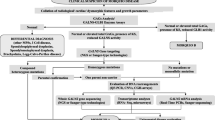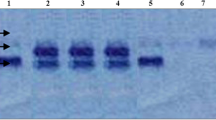Abstract
Four unrelated Japanese patients with infantile Sandhoff disease (β-hexosaminidase β-subunit deficiency) have been studied for the molecular basis of their severe phenotype. Two patients had complex base substitutions; one patient was homoallelic for a triple mutation (P417L, K121R, and S255R) and the other was a compound heterozygote of a double (P417L and K121R) mutation and the triple mutation. K121R is known to be a functional polymorphism, while P417L (exon 11, +8 C→T) generates predominantly an abnormally spliced mRNA at base +112 of exon 11 and has been described in two patients with a juvenile form of the disease. The mild phenotype is attributed to the presence of a small amount of normally spliced mRNA. S255R is a novel mutation without prior description in the literature. An expression study of the normally spliced cDNA with the double and the triple mutations gave about 70% and 30% of normal activity, respectively. This finding suggests that S255R further reduces the catalytic activity of the already below-threshold amount of normally spliced mRNA and accounts for the more severe phenotype in our patients. In the other two patients, a novel disease-causing base transition was found within intron 10, away from the intron/exon junction (–17 a→g). This mutation caused abnormal 3’ splicing at position –37 of intron 10, and no normally spliced product was detectable upon RT-PCR analysis. We noted an unusually low splice site score (61.8) for the exon 10/intron 11 junction and suspected that this might be partially responsible for the aberrant splicing in these mutations. To test this hypothesis, we constructed four chimeric cDNAs all with an additional intron 10 inserted and evaluated their splicing efficiency. They, respectively, had the normal sequence, P417L (exon 11, +8 C→T), the intronic mutation (–17 a→g), and the intronic mutation with an artificially engineered intron 10/exon 11 junction of a higher splice site score (85.1). Of the total transcripts, 67% and 32% were correctly spliced in the normal chimeric construct and P417L, respectively, while no normally spliced product was generated either in the chimeric construct with –17 a→g or in that with a high splice site score. The sequence around the adenosine –17 residue upstream of the normal acceptor splice site in this report, UGCAAU (–21 to –16), matches the consensus branchpoint sequence YNYRAY (Y, pyrimidine; R, purine; N, any base) reported in the literature. The mutation in this study is most likely to abolish lariat formation because the artificial site of the high splice site score did not improve splicing efficiency.
Similar content being viewed by others
Author information
Authors and Affiliations
Additional information
Received: 30 April 1998 / Accepted: 7 August 1998
Rights and permissions
About this article
Cite this article
Fujimaru, M., Tanaka, A., Choeh, K. et al. Two mutations remote from an exon/intron junction in the β-hexosaminidase β-subunit gene affect 3’-splice site selection and cause Sandhoff disease. Hum Genet 103, 462–469 (1998). https://doi.org/10.1007/s004390050851
Issue Date:
DOI: https://doi.org/10.1007/s004390050851




